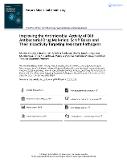Improving the antimicrobial activity of old antibacterial drug mafenide: Schiff bases and their bioactivity targeting resistant pathogens

Autor
Šimková, Adéla
Maixnerová, Jana
Stolaříková, Jiřina
Voxová, Barbora
Datum vydání
2023Publikováno v
Future Medicinal ChemistryRočník / Číslo vydání
15 (3)ISBN / ISSN
ISSN: 1756-8919ISBN / ISSN
eISSN: 1756-8927Metadata
Zobrazit celý záznamTato publikace má vydavatelskou verzi s DOI 10.4155/fmc-2022-0259
Abstrakt
Background: Increasing rates of acquired resistance have justified the critical need for novel antimicrobial drugs. One viable concept is the modification of known drugs. Methods & results: 21 mafenide-based compounds were prepared via condensation reactions and screened for antimicrobial efficacy, which demonstrated promising activity against both Gram-positive and Gram-negative pathogens, pathogenic fungi and mycobacterial strains (minimum inhibitory concentrations from 3.91 mu M). Importantly, they retained activity against a panel of superbugs (methicillin- and vancomycin-resistant staphylococci, enterococci, multidrug-resistant Mycobacterium tuberculosis) without any cross-resistance. Unlike mafenide, most of its imines were bactericidal. Toxicity to HepG2 cells was also investigated. Conclusion: Schiff bases were significantly more active than the parent drug, with iodinated salicylidene and 5-nitrofuran/thiophene-methylidene scaffolds being preferred in identifying the most promising drug candidates.
Klíčová slova
antibacterial activity, antifungal activity, antimycobacterial activity, cytotoxicity, drug resistance, enterococci, imine, mafenide, Schiff bases, staphylococci
Trvalý odkaz
https://hdl.handle.net/20.500.14178/1805Licence
Licence pro užití plného textu výsledku: Creative Commons Uveďte původ 4.0 International







